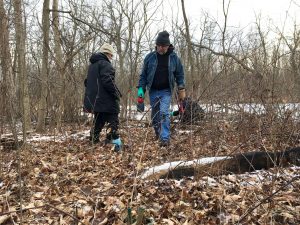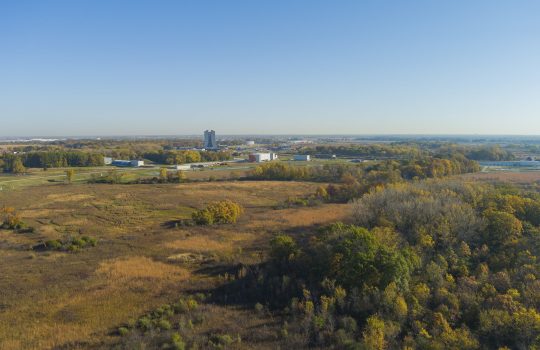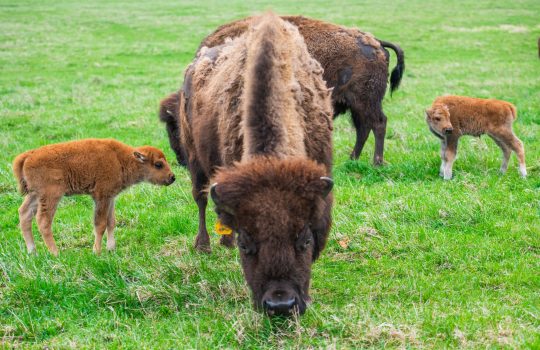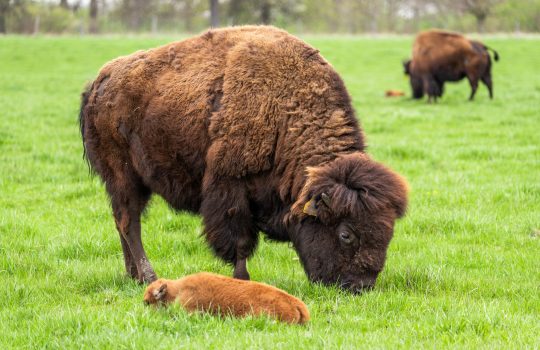
Volunteers carry the tools they need to fight back invasive species on the Fermilab site. Photo: Dan Garisto
Half a dozen local retirees gathered in the cold on a dreary weekday afternoon at Fermilab.
They were on the hunt for three invasive species: multiflora rose, buckthorn and honeysuckle. Carrying saws, hedge clippers and herbicides, the volunteers were ready to take on the invading plants. Chatting amiably with one another, they cut down invasive plants and carefully spritzed the roots with herbicide to prevent the plants from growing back.
Protective gear such as knee pads, thick gloves and safety glasses held thorns and branches at bay and prevented contact with the herbicides (which the volunteers are licensed to use by the state of Illinois).
After several hours, they departed, leaving behind a landscape where native species could once again flourish.
The volunteers who work with Fermilab ecologist Ryan Campbell to do this bushwhacking every winter are generally retirees who become involved because they find the work of preservation satisfying. For many of the volunteers, it becomes more than just a way to pass the time, and conservation becomes an active part of their life.
Penny Kasper, formerly a Fermilab physicist, is the president of Fermilab Natural Areas. Under her watch, the nonprofit organization helps conservation efforts across Fermilab’s 6,800 acres.
Kasper, like other volunteers, said she just got “sucked into it.” Some volunteers become so dedicated to the mission of removing invasive species that they carry hedge clippers with them in their car, just in case. Those pesky invasive species are a threat that requires dedicated action.
“If a habitat is not lost through development of some kind, the second greatest threat to habitat quality is invasive species,” Campbell said.
Invasive species are usually foreign or exotic species that are relatively new to the area. Because these plants and animals aren’t local, they don’t often have predators to hold them in check, and so they become out of control. For example, the brown tree snake has decimated the bird population of Guam because it has no natural predators there. This doesn’t happen in every case: Peaches are originally from China but aren’t invasive, even in Georgia, where they grow well.
“One thing that’s kind of a big misconception is that all non-native species are invasive, or all exotic plants are invasive,” Campbell said. “That’s not true. You can even have some native species that we would consider invasive depending on the situation.”
The main characteristic of invasive species is that they out-compete others in the area, like weeds in a garden. Multiflora rose, an invasive winding vine peppered with sharp thorns originally from east Asia, coils around itself like barbed wire and crowds out other plants. Removing it is made more difficult by the fact that it’s tough to distinguish from plants like black raspberry.
“There’s a lot of ways that organisms compete to survive,” Campbell said. “Invasive species can use a lot of different methods: They could be fast-growing and produce a lot of seeds like garlic mustard, or be like buckthorn, which can produce a chemical that inhibits the growth of other plants.”
Ecologists can measure the extent of an invasive plant’s spread by looking at the percent cover — a rough measure of how much of the area is taken up by the invasive species. Reducing cover from invasive species can be done through precision means, such as targeting individual plants, or the use of controlled fires.
Previously, before conservation efforts took root at Fermilab, invasive species could be found across the lab. Their presence could crowd out smaller plants, like wildflowers. But thanks to efforts from volunteers, visiting students and Fermilab’s Roads and Grounds Crew, the spread of invasive species has been pushed back.
Now, the native wildflowers bloom every year.



